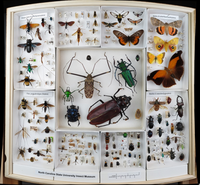 Drawer of insects from the NCSU Insect Museum. | |
 | |
| Established | 1952 |
|---|---|
| Location | North Carolina State University, Raleigh, North Carolina |
| Coordinates | 35°47′15″N78°40′21″W / 35.787638°N 78.67262°W |
| Type | Natural History Museum |
| Collection size | 1.5 million specimens |
| Website | insectmuseum.org |
The North Carolina State University Insect Museum is the center for research and training in insect systematics and biodiversity informatics at North Carolina State University. The Museum's collections hold more than 1.5 million specimens, [1] with major emphases on the insects of North Carolina and on the Auchenorrhyncha and Aphididae (Hemiptera) of the world. A smaller but historically important part of the collection (especially for bees of the eastern USA) is dedicated to Hymenoptera. [2]